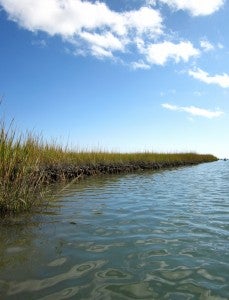
Callie Eideberg, EDF’s new senior policy manager for sustainable agriculture.
We often hear about the deep-rooted water quality challenges in the Chesapeake Bay, and how not enough progress is being made. While agriculture, urban/suburban runoff, vehicle emissions, and other sources share responsibility for the bay’s poor health, all too often farmers shoulder most of the blame.
Earlier this month, USDA released the Chesapeake Bay Progress Report, which revealed that since 2009, federal investments helped area farmers implement nearly $1 billion worth of conservation practices on more than 3.5 million acres and install nearly 3,500 miles of riparian buffers that reduce nutrient runoff into waterways. Between 2006 and 2011, farmer efforts reduced sediment loss by 15.1 million tons per year.
This is encouraging news, and part of the reason the overall health of the bay is improving. Supporting farmers and their livelihoods is key to solving the watershed’s environmental challenges. As the report notes, “a thriving and sustainable agricultural sector is critical to restoring the bay.”
There is still a lot of work to do. Because a significant increase in public funding is unlikely, relying too heavily on federal investment in voluntary conservation programs is not a good pathway to fully heal the bay.
Here are two ways that agriculture can further accelerate improvements in the watershed.
Support private sector momentum

Photo courtesy of SUSTAIN.
Private sector commitments to sustainable agriculture are on the rise. Environmental Defense Fund is working with Campbell Soup Company, Kellogg, Walmart, Unilever, Smithfield Foods, and through Land O’Lakes’ SUSTAIN® platform to help companies set and achieve sustainable sourcing goals and support farmers through tangible, economically smart improvements to their farming operations.
Getting the food sector on board is a game changer for agricultural sustainability, but if we don’t align key federal policies with this unprecedented supply chain momentum, we will hit roadblocks that will compromise progress and alienate stakeholders.
Federal policy has not kept pace with private sector innovation. One example is advances in precision agriculture. In many cases, federal programs encourage farmers to adopt older practices that are often less effective in reducing fertilizer losses or improving soil health, failing to provide farmers with access to more advanced tools for improving efficiency.
Keeping up with innovation would enable current federal investments to deliver far greater environmental benefits. It is time to have federal policies accelerate market demand for agricultural conservation instead of slow it down.
Increase impact of current programs

Credit: Chesapeake Bay Program
As the USDA report suggests, federal conservation programs have been successful in helping to reduce nutrient loading into the bay. But they can be even more effective by making a few adjustments, such as:
- Improving targeting of federal funds to the most important places and practices (e.g., the watersheds in most need of restoration).
- Streamlining program delivery and execution by reducing inefficient contracting requirements.
- Improving collaboration between USDA and the private sector advisors that work with the vast majority of U.S. farmers (ag retail, agronomists, etc.).
These changes will enable federal programs to better meet the needs of farmers and agribusinesses, resulting in more conservation on the ground.
With additional investments in innovation and collaboration with the private sector, we can return Chesapeake Bay to its former glory.










One Comment
There is a lot of state and federal money available to put in conservation practices like ditch and riparian buffers using the CRP and CREP. However, most farmers will not install buffers. So let’s not mislead the public into thinking that this is a funding problem. It is a fact that most farmers do not want to install conservation practices that take ANY land out of production even when CREP rental rates are more profitable than farming. CREP acreage in Maryalnd has fallen from a high of 75,000 acres to a current level of about 55,000 acres which is around 2% of Maryland’s tillable acreage. Many farmers just do not care about their downstream impacts